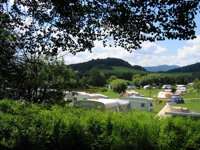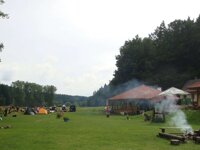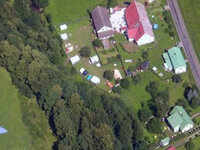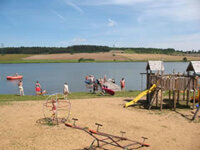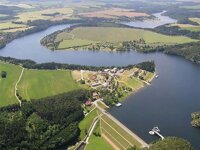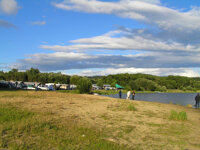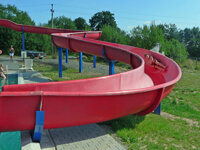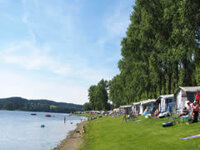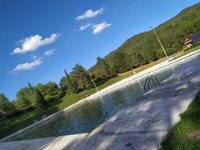Camping in the Czech Republic
45 campsites in Czech Republic
Campsite Listing Google Map
The following consent is required:
Tracking & performance, Targeting & advertising.
Czech Republic
When most people think of the Czech Republic, they immediately think of Prague, its historic and enchanting capital. But while there’s every reason to discover this buzzing city, camping in the Czech Republic can offer a more laid-back, scenic experience if you’re willing to find it.
The eastern region of Moravia borders Poland, Slovakia and Austria and is characterised by the jagged peaks of mountain ranges such as the White Carpathians, which form its eastern boundary. The rolling countryside is peppered with small vineyards, which can be explored by bicycle, and the Moravian Karst region is a landscape steeped in myth that features some of the country's most exceptional scenery. Boat trips run along the subterranean River Punkva, enabling you to explore the famous Macocha Abyss, a cavern 138m deep.
A trip to Prague is undoubtedly worth the effort, even if you're camping in the Czech Republic to escape city life. Romantic and changeable, it is a cosmopolitan capital with numerous cultural influences most apparent in its diverse assortment of architectural styles, from Gothic and Rococo to Cubist. Sample traditional Czech cuisines, such as Silesian pierogi, potato dough filled with pork crackling, sauerkraut or smoked meat, in one of the speciality restaurants and wash it down with a refreshing beer.
Unknown matrix block type: tableOfContents2!
Basic Information

Capital Prague
Currency Czech Koruna
Language(s) Czech
Time Zones CET (GMT+1)
Summer (DST) CEST (UTC+02)
Telephone Code +420
Units Metric
EU Member Yes
Schengen Area Yes
Tourism Website visitczechrepublic.com
The Czech Republic is a member of the European Union, and customs inspections are occasionally conducted on individuals and vehicles crossing the border to ensure compliance with Croatian regulations.
Shopping in the Czech Republic

The Czech Republic is quite the traveller's paradise and a trendy destination for shopping. One fact about the country is that it has the highest density of shopping centres per person on the continent, so if you are looking for a great shopping experience Prague and the Czech Republic's other cities are great places to explore.
Chodov Shopping Centre is the biggest shopping mall in Prague. Commonly known as Chodov, it is located in the heart of the capital city and entertains over 13 million people every year from all corners of the world. In addition to shops of world-famous brands, the vast centre also houses a cinema, restaurants and cafes.
Prague's most excellent density of shopping addresses can be found at the "Golden Cross", not far from Wenceslas Square and Old Town Square. Luxury labels have set up shop on Paris Street, a famous shopping street that forms a transition between the Old and New Towns.
Kolbenova Flea Market in Prague is a great market to explore for those who like to collect unusual things and objects with history. This is the largest flea market in the Czech Republic, where stallholders sell antiques and new items of different value. The market is open on weekends from 7:00 a.m. to 2:00 p.m.
Stores outside Prague and on the outskirts tend to open at 8 or 9 a.m. (large grocery stores at 7 a.m.) and close at 6 or 7 p.m. Some stores are closed during lunch hours. The hours are shorter on Saturdays, and most stores, except supermarkets, are closed on Sundays.
Stores in the centre of Prague and shopping malls have longer hours. Supermarkets stay open until 8 or 10 p.m.; some are open 24 hours daily. Most stores in the Prague city centre and tourist locations are available on weekends.
Czech Republic Money

As a tourist in the Czech Republic, it is relatively easy to obtain the local currency, the Czech koruna (CZK), sometimes referred to as the Czech crown in English and the koruna Česká (Kč) in Czech. Most major cities and tourist areas have banks, ATMs, and exchange bureaus that offer currency exchange services. ATMs are widely available in most cities and towns, and they typically accept major credit and debit cards, such as Visa, Mastercard, and Maestro.
The best exchange rates are usually found in bureaux de change. Banks typically charge a 2% commission, and hotels and airport currency exchange are traditionally more expensive, so it's worth shopping around to find the best deal. It's also advisable to carry a mix of cash and cards, as some smaller shops and restaurants may not accept cards, particularly in more rural areas.
Obtaining local currency in the Czech Republic is relatively straightforward, and most major payment methods are widely accepted. It's always a good idea to inform your bank or credit card company of your travel plans to avoid any issues with card usage while abroad.
Public Holidays
- New Year's Day: 1st January
- Good Friday, Easter Monday
- May Day: 1st May
- Liberation Day: 8th May
- St Cyril and St Methodius Day: 5th July
- Jan Hus Day: 6th July
- Statehood Day: 28th September
- Independence Day: 28th October
- Freedom and Democracy Day: 17th November
- Christmas Eve: 24th December
- Christmas Day: 25th December
- 2nd Day of Christmas: 26th December
Please note Some dates are moveable, so please check before travelling.
Driving in the Czech Republic

Visitors to Croatia who wish to drive in the country must comply with the following requirements:
- A valid driver's license: Visitors must have a valid driver's license from their home country.
- Car insurance: Visitors must have valid car insurance for their vehicle, covering both the driver and passengers.
- Road rules: Czech Republic traffic laws follow the right-hand side of the road. Overtake on the left. The use of seat belts is mandatory for all occupants of a vehicle. Visitors must follow Czech Republic traffic laws, including speed limits, traffic signals, and road signs.
- Safety equipment: It is mandatory to carry a warning triangle, reflective vest, Headlamp beam deflectors and first aid kit.
- Minimum driving age: The minimum driving age is 18 years old.
- Alcohol law: Drinking and driving are strictly forbidden; you will be penalized for anything above 0% blood alcohol level.
- Winter tires: Winter tyres are compulsory from 1 November to 31 March on all wheels of passenger vehicles when there is compacted snow or ice on the road or if it’s expected.
Czech Republic Emergency Services
- European Emergency Number 112
- Police 158
- Fire Department 150
- Ambulance 155
- Help on the road 1230
Czech Republic Climate
CZECH REPUBLIC WEATHER
The Czech Republic has a temperate climate in the transition zone between the oceanic and continental climate types, with warm summers and cold, cloudy and snowy winters. The temperature difference between summer and winter is due to the landlocked geographical position.
Temperatures vary depending on the elevation. In general, at higher altitudes, the temperatures decrease and precipitation increases. The wettest area in the Czech Republic is found around Bílý Potok in the Jizera Mountains, and the driest region is the Louny District to the northwest of Prague.
In Prague, the summers are comfortable; the winters are very cold, snowy, windy, and partly cloudy year-round. Over the year, the temperature typically varies from -3°C to 25°C and is rarely below -12°C or above 31°C.



